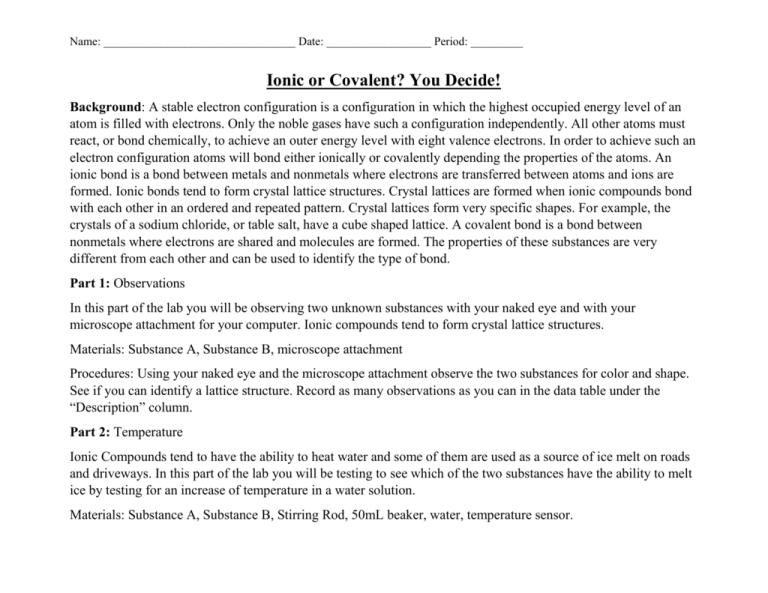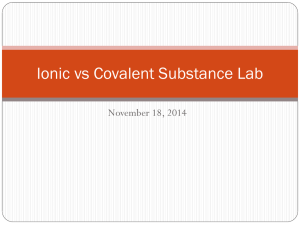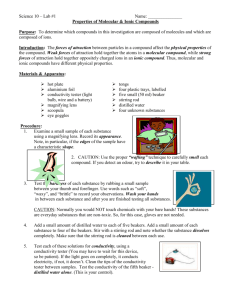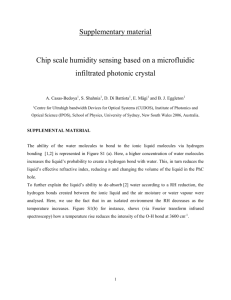Ionic or Covalent?
advertisement

Name: _________________________________ Date: __________________ Period: _________ Ionic or Covalent? You Decide! Background: A stable electron configuration is a configuration in which the highest occupied energy level of an atom is filled with electrons. Only the noble gases have such a configuration independently. All other atoms must react, or bond chemically, to achieve an outer energy level with eight valence electrons. In order to achieve such an electron configuration atoms will bond either ionically or covalently depending the properties of the atoms. An ionic bond is a bond between metals and nonmetals where electrons are transferred between atoms and ions are formed. Ionic bonds tend to form crystal lattice structures. Crystal lattices are formed when ionic compounds bond with each other in an ordered and repeated pattern. Crystal lattices form very specific shapes. For example, the crystals of a sodium chloride, or table salt, have a cube shaped lattice. A covalent bond is a bond between nonmetals where electrons are shared and molecules are formed. The properties of these substances are very different from each other and can be used to identify the type of bond. Part 1: Observations In this part of the lab you will be observing two unknown substances with your naked eye and with your microscope attachment for your computer. Ionic compounds tend to form crystal lattice structures. Materials: Substance A, Substance B, microscope attachment Procedures: Using your naked eye and the microscope attachment observe the two substances for color and shape. See if you can identify a lattice structure. Record as many observations as you can in the data table under the “Description” column. Part 2: Temperature Ionic Compounds tend to have the ability to heat water and some of them are used as a source of ice melt on roads and driveways. In this part of the lab you will be testing to see which of the two substances have the ability to melt ice by testing for an increase of temperature in a water solution. Materials: Substance A, Substance B, Stirring Rod, 50mL beaker, water, temperature sensor. Name: _________________________________ Date: __________________ Period: _________ Procedure: Fill each 50 mL beaker to the 40mL line with room temperature water. Place your temperature sensor into the water to obtain an initial temperature reading. Record your data in the data table under “Initial Temperature”. Place a small amount of substance A into the first beaker and stir. Place your temperature sensor in the solution and check for a temperature increase. Allow two minutes for the substance to increase the temperature before taking the final temperature reading. While you are waiting you can prepare substance B in the second beaker. Record you data under the “Final Temperature” column. Subtract the initial temperature from the final temperature to calculate the change in temperature. Record this data in the data table under the “Change in Temperature” column. Part 3: Solubility in Water and Conductivity In this part of the lab you will be attempting to dissolve the substances in water and test each solution for conductivity. Conductivity is the ability of a substance to conduct electricity. Materials: Substance A, Substance B, Stirring Rod, 50mL beaker, water, conductivity tester Procedure: Fill each 50mL beaker to the 40mL line with water. Place a small amount of substance A into your first beaker and a small amount of substance B into your second beaker. Be careful not to add too much of each substance to the water. Stir both beakers with separate stirring rods or clean the stirring rod before transferring it from one solution to the next. Record your observations in the data table under the “Soluble in water” Column. Place the electrodes of the conductivity testers in the solution for substance A and turn it on. If the bulb lights up then the solution conducts electricity. If the light does not light up the bulb does not conduct electricity. Be sure to clean the electrodes with water before transferring them to substance B. Test Substance B for conductivity following the same procedures for substance A. Record your results in the data table under the “Conducts Electricity” Column. Part 4: Solubility in Alcohol In this part of the lab you will be attempting to dissolve the substances in alcohol. Name: _________________________________ Date: __________________ Period: _________ Materials: Substance A, Substance B, Stirring Rod, 50mL beaker, alcohol. Procedures: Fill each 50mL beaker to the 40mL line with alcohol. Place a small amount of substance A into your first beaker and a small amount of substance B into your second beaker. Be careful not to add too much of each substance to the alcohol. Stir both beakers with separate stirring rods or clean the stirring rod before transferring it from one solution to the next. Record your observations in the data table under the “Soluble in Alcohol” Column. Clean Up: All substances and solutions can be rinsed down the sink. Please clean all glassware and return it to the lab table. Clean all sensors, place them back in their packages, and return them to Mr. King. Name: _________________________________ Date: __________________ Period: _________ Data Table: Compound Substance A Substance B Description Initial Temperature Final Temperature Change in Temperature Soluble in water Conducts Electricity Soluble in Alcohol Name: _________________________________ Date: __________________ Period: _________ Post Lab Questions: 1. Define chemical bond: 2. Define Ionic Bond: 3. Define Covalent Bond: 4. Define Crystal Lattice: 5. Did either substance appear to have a crystal lattice structure? Which one? 6. Which of the two substances was soluble in water? 7. Which of the two substances was soluble in alcohol? 8. Which substance was a conductor of electricity? 9. Which substance showed an increase of temperature in the solution? 10.Is substance A ionic or covalent? 11.Is substance B ionic or covalent?






